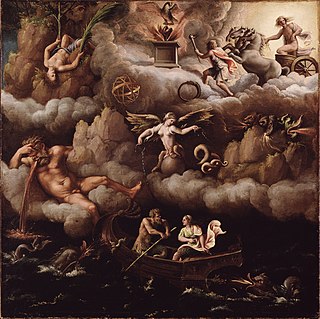Cryptozoology is a pseudoscience and subculture that searches for and studies unknown, legendary, or extinct animals whose present existence is disputed or unsubstantiated, particularly those popular in folklore, such as Bigfoot, the Loch Ness Monster, Yeti, the chupacabra, the Jersey Devil, or the Mokele-mbembe. Cryptozoologists refer to these entities as cryptids, a term coined by the subculture. Because it does not follow the scientific method, cryptozoology is considered a pseudoscience by mainstream science: it is neither a branch of zoology nor of folklore studies. It was originally founded in the 1950s by zoologists Bernard Heuvelmans and Ivan T. Sanderson.

The chupacabra or chupacabras is a legendary creature in the folklore of parts of the Americas, with its first purported sightings reported in Puerto Rico in 1995. The name comes from the animal's reported vampirism—the chupacabra is said to attack and drink the blood of livestock, including goats.

A vampire is a mythical creature that subsists by feeding on the vital essence of the living. In European folklore, vampires are undead creatures that often visited loved ones and caused mischief or deaths in the neighbourhoods which they inhabited while they were alive. They wore shrouds and were often described as bloated and of ruddy or dark countenance, markedly different from today's gaunt, pale vampire which dates from the early 19th century. Vampiric entities have been recorded in cultures around the world; the term vampire was popularized in Western Europe after reports of an 18th-century mass hysteria of a pre-existing folk belief in Southeastern and Eastern Europe that in some cases resulted in corpses being staked and people being accused of vampirism. Local variants in Southeastern Europe were also known by different names, such as shtriga in Albania, vrykolakas in Greece and strigoi in Romania.

A monster is a type of fictional creature found in horror, fantasy, science fiction, folklore, mythology and religion. Monsters are very often depicted as dangerous and aggressive with a strange, grotesque appearance that causes terror and fear. Monsters usually resemble bizarre, deformed, otherworldly and/or mutated animals or entirely unique creatures of varying sizes, but may also take a human form, such as mutants, ghosts and spirits, zombies or cannibals, among other things. They may or may not have supernatural powers, but are usually capable of killing or causing some form of destruction, threatening the social or moral order of the human world in the process.

In Canadian folklore, the Ogopogo is a lake monster said to inhabit Okanagan Lake in British Columbia, Canada. Some scholars have charted the entity's development from First Nations folklore and widespread water monster folklore motifs. The Ogopogo now plays a role in the commercial symbolism and media representation of the region.
Karl Shuker is a British zoologist, cryptozoologist and author. He lives in the Midlands, England, where he works as a zoological consultant and writer. A columnist in Fortean Times and contributor to various magazines, Shuker is also the editor-in-chief of the Journal of Cryptozoology, which began in November 2012.

Species is a 1995 American science fiction horror film directed by Roger Donaldson and written by Dennis Feldman. It stars Ben Kingsley, Michael Madsen, Alfred Molina, Forest Whitaker, Marg Helgenberger, and Natasha Henstridge in her film debut role. The film's plot concerns a motley crew of scientists and government agents who try to track down Sil (Henstridge), a seductive extraterrestrial-human hybrid, before she successfully mates with a human male.
In the folklore of Lee County, South Carolina, the Lizard Man of Scape Ore Swamp is an entity said to inhabit the swampland of the region. First mentioned in the late 1980s, the purported sightings and damage attributed to the creature yielded a significant amount of newspaper, radio and television publicity.

Joe Nickell is an American skeptic and investigator of the paranormal.
The Beast of Bray Road, also known as the Bray Road Beast and the Wisconsin Werewolf, is a purported humanoid wolf-like creature allegedly witnessed in or near the rural community of Elkhorn, Walworth County, Wisconsin. It has since become a part of Wisconsin folklore and has been the subject of multiple books, documentaries and a 2005 horror film.

Benjamin Radford is an American writer, investigator, and skeptic. He has authored, coauthored or contributed to over twenty books and written over a thousand articles and columns on a wide variety of topics including urban legends, unexplained mysteries, the paranormal, critical thinking, mass hysteria, and media literacy. His book, Mysterious New Mexico: Miracles, Magic, and Monsters in the Land of Enchantment, was published in the summer of 2014 and is a scientific investigation of famous legends and folklore in the state of New Mexico. In 2016 Radford published Bad Clowns, a 2017 IPPY bronze award winner, and he is regarded as an expert on the bad clowns phenomenon.

The Thetis Lake Monster is a legendary creature and admitted hoax of Victoria, British Columbia, Canada. In 1972, two teenage boys claimed to see a monster emerge from Thetis Lake beach. The description of the creature that the teenagers gave matched the description of the Gill-man from the 1954 film Creature from the Black Lagoon.

Lukwata is a legendary water-dwelling creature in Baganda folklore, said to be found in Lake Victoria of Uganda. It has been described as 20–30 feet long, with dark smooth skin and a rounded head, and known to attack fishermen and boats. It's stories and folklore may have also been related in some way to stories of spirits and deities surrounding canoes and fishing. Pieces of the Lukwata were thought to have magical properties and were revered as relics in eastern Africa.

Proof is an American comic book series, published by Image Comics and created by writer Alex Grecian and artist Riley Rossmo. The story concerns John "Proof" Prufrock, a sasquatch, who works for a secret government organization. He hunts cryptids with his partner, Ginger Brown, and seeks clues to his past. The book was influenced by The X-Files and Tarzan.

Lost Tapes is an American fiction television series that aired on Animal Planet. Produced by Go Go Luckey Entertainment, the program presents fictional found footage depicting traumatic encounters with creatures cryptozoological, supernatural, mythological or extraterrestrial. Creatures featured include Bigfoot, the chupacabra, vampires, werewolves, and reptilians.

The Beast of Bladenboro refers to a creature responsible for a string of deaths amongst Bladenboro, North Carolina animals in the winter of 1953–54. According to witnesses and trackers, it was likely a wildcat species, but its identity was ultimately not definitively confirmed. According to reports, the animal commonly crushed or decapitated its victims, which were mostly dogs.
In folklore, the Michigan Dogman was allegedly witnessed in 1887 in Wexford County, Michigan, United States. The creature is described as a seven-foot tall, blue-eyed, or amber-eyed bipedal canine-like animal with the torso of a man and a fearsome howl that sounds like a human scream. According to legends, the Michigan Dogman appears in a ten-year cycle that falls on years ending in 7. Sightings have been reported in several locations throughout Michigan, primarily in the northwestern quadrant of the Lower Peninsula. In 1987, the legend of the Michigan Dogman gained popularity when disc jockey Steve Cook at WTCM-FM recorded a song about the creature and its reported sightings.

MonsterTalk is an audio podcast originally presented by the Skeptics Society's Skeptic magazine but broke ties in 2019. Since 2019 it has been an independent podcast under the "Monster House, LLC" banner. The show critically examines the science behind cryptozoological creatures, such as Bigfoot, the Loch Ness Monster, and werewolves. It is hosted by Blake Smith and Karen Stollznow, and produced by Blake Smith. In 2012, MonsterTalk was awarded the Parsec Award for the "Best Fact Behind the Fiction Podcast".











